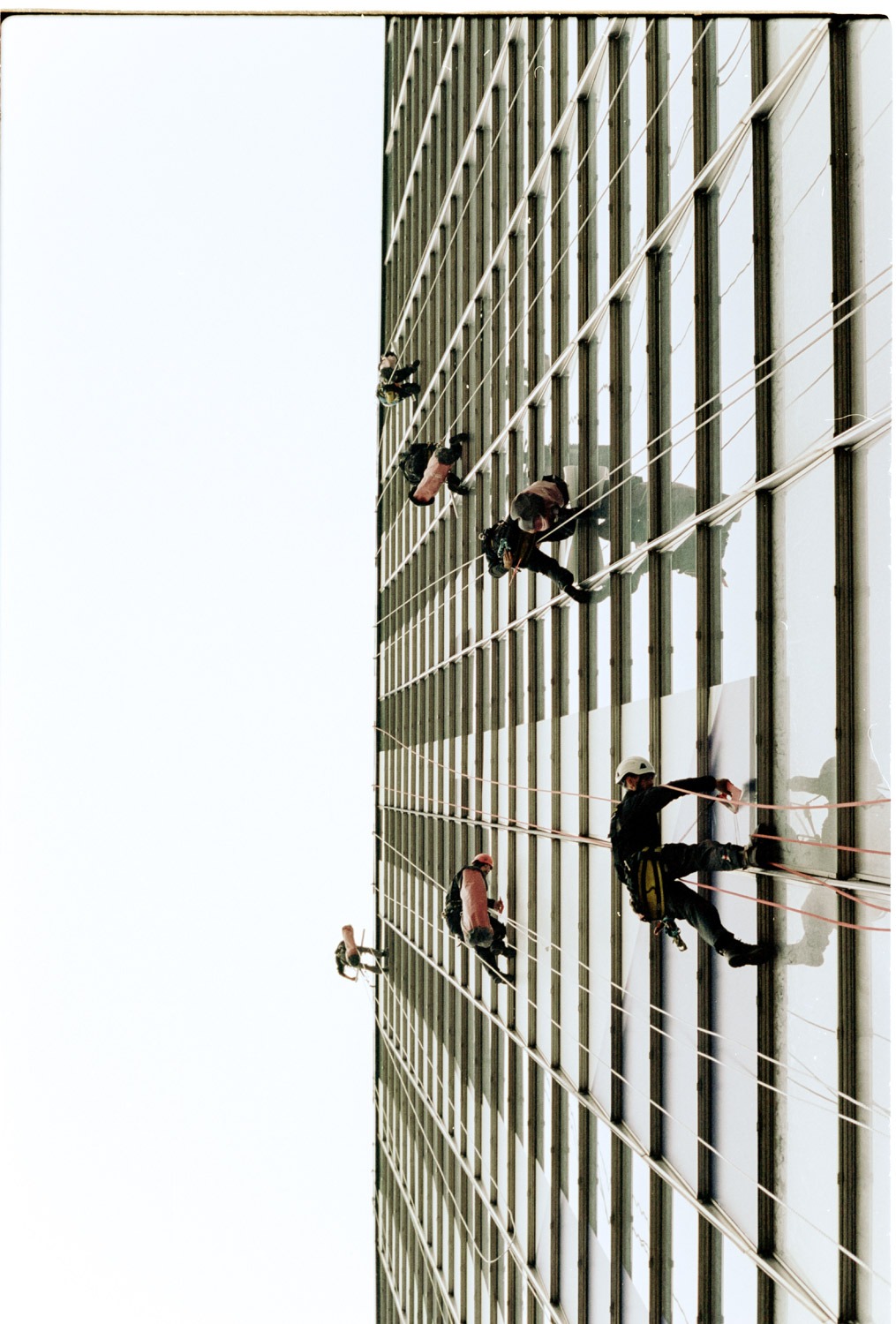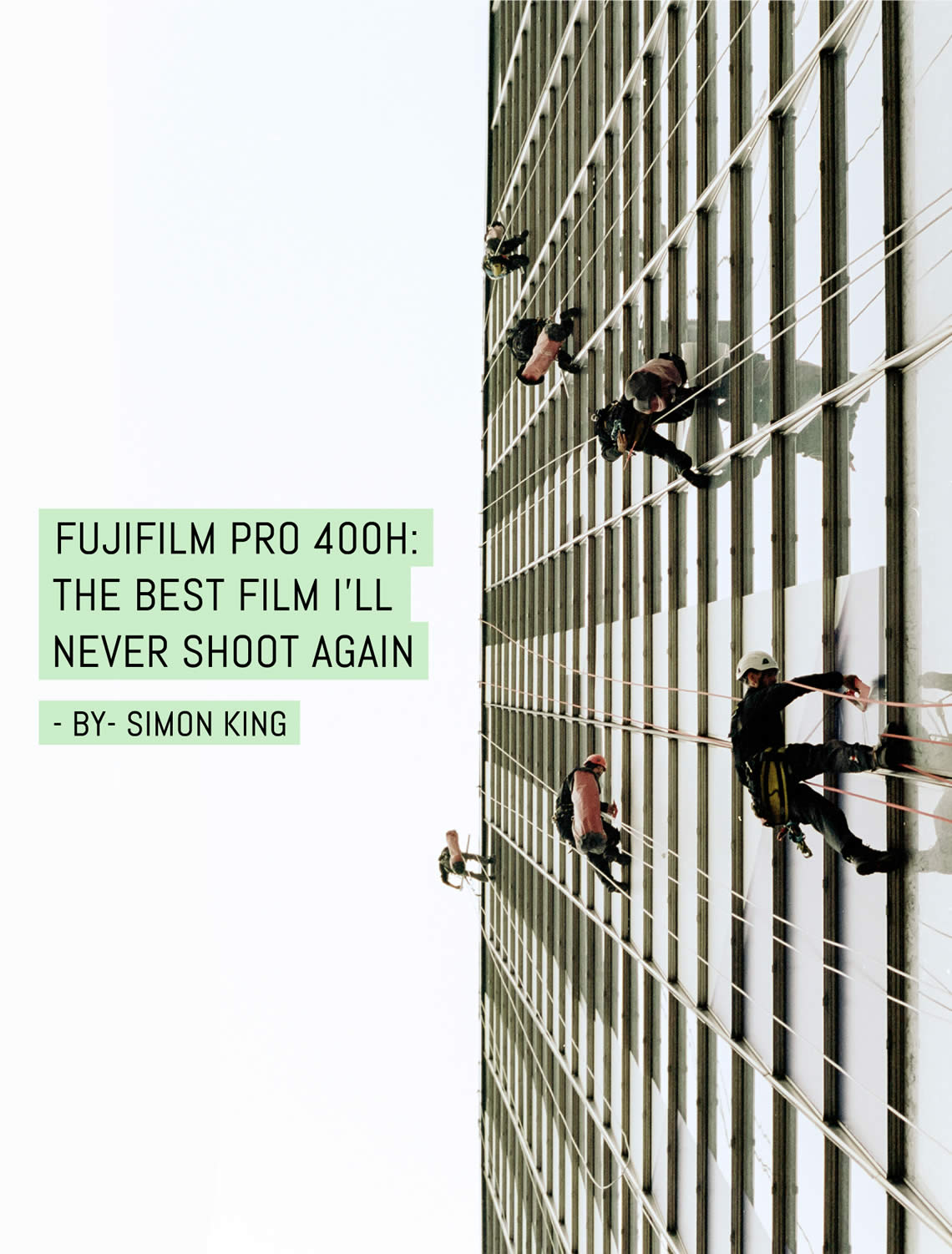A lot of my early digital work was rooted in colour theory, and as a result (despite wanting to limit my film photography to black and white) I have shot through as many different colour films as I could find. Although there are any number of looks that can be achieved from shooting a colour film for photographers who want reliability and dependability there are only a few films that can hold up to different conditions and a variety of exposure types while delivering clean and beautiful results.
The cliched “favourites” are favoured for a reason, and while some may opt for the outliers specifically in order to give themselves an “edge” there will always be a demand for these robust films. Of these options, I was very interested in what could be done with FujiFilm Pro 400H.


My colour work (at it’s best) features a minimal palette of bold colours, on an image-to-image level. I don’t have specific goals in mind other than to accurately represent the scene in front of me and to reduce down through composition any distracting elements. This means that when I decided to try Pro 400H I wasn’t necessarily looking for anything specific from the experience. I was open-minded as to how the images would turn out and wasn’t doing anything specific to elicit some “look” from the images.
I bought 20 rolls and took my time working my way through them. I am not a fast shooter, and it is a rarity for me to finish an entire roll of film in a day, let alone a week. I’ve shot through all of them, finishing up the last in April 2019 on a day-trip to Brighton.
I think that even based on my limited use I can agree with the majority of positive reviews online. It is a strong film with light colours, and excellent latitude, based on a range of shooting situations. It has wonderful grain and wonderful sharpness, and especially excellent rendering during golden hour.


There is often a blue-green tint, even after my best efforts at colour correction, but I really like these calm tones, and prefer them to the yellow-gold of common Kodak films. As a film, it doesn’t have many shortcomings, and I really enjoyed the images I made while using it. I definitely personally prefer the rendering of colour and grain to the equivalent Kodak Portra 400 and think that the dynamic range is just as good.
However there is a large caveat to my Pro 400H experience. That is, as of April 1st 2019, FujiFilm introduced a global price increase of at least 30% on all colour films. This means that at the time of writing this, a single roll of Pro 400H is listed with an RRP of £20 on Analogue Wonderland, which is where I source the majority of my film and is usually one of the cheaper options.
With Portra 400 listed at £10, it stands at half this price, while offering pretty much the same performance. Paying double what I would if I went with the competition for slight aesthetic differences is quite difficult for me to justify, especially as I mostly shoot black and white films – £20 could equally be spent on five boxes of ILFORD’s Kentmere 400 (which is a wonderful film for everyday use) with change.
At £20 that’s even more expensive than Fujifilm Provia 100F, my favourite of Fujifilm’s £6 slide film offerings!


I always knew that shooting film would not be a cheap pursuit, and considering I shoot on mainly Leica rangefinders this may sound miserly, however, I think that the role of community and the capacity of consumers to “vote with their wallets” is underrated. I don’t know the intimate workings of Fujifilm as a company, only how their decisions affect me. I know that film photography, while experiencing a resurgence in popularity, is going to struggle for some time and that it’s down to passionate communities such as this website, to support the brands they want to see survive.
I don’t want to rely on a film stock that runs the risk of being killed off, as Fujifilm has done with many other lines. I think the re/introduction of NEOPAN 100 ACROSS (II) is a reassuring step, but not a sure-footed one. As it is I feel much more comfortable spending my money with Kodak and ILFORD, as well as Cinestill which seems to be making a large effort to produce interesting stocks, to which the film community has responded by using those films to create some wonderful images.
Innovation is one of the keys to industry, and although I can understand why it may be a financial niche to cater for film photography still welcomes innovation wherever it can be found, for both serious and hobbyist uses. The current in-production lines of film represent the culmination of all film production technologies, but when those become unreachable for the majority the entire industry becomes more of a niche.



My thoughts on Fujifilm Pro 400h echo a similar write up I produced for 35mmc, about my experience “chasing the black and white dragon” of another Fujifilm stock: NEOPAN Professional 400. I wrote there about my search to simply experience an emulsion which is no longer in production, and the annoyance I felt that I would never be able to really feel comfortable in the process of using something which is now extinct.
As I also said there it is an odd feeling, knowing that at any time any of my “safe” film options, like ILFORD Delta 400, or Kodak Portra could suffer the fate of being priced out of reach, or simply axed entirely. It’s down to the vocal members of our community to demonstrate though their own innovation and storytelling that film is not only very much alive, but has a foreseeable future as a valid method of artistry, journalism, and nostalgia.
~ Simon
Share your knowledge, story or project
The transfer of knowledge across the film photography community is the heart of EMULSIVE. You can add your support by contributing your thoughts, work, experiences and ideas to inspire the hundreds of thousands of people who read these pages each month. Check out the submission guide here.
If you like what you’re reading you can also help this passion project by heading over to the EMULSIVE Patreon page and contributing as little as a dollar a month. There’s also print and apparel over at Society 6, currently showcasing over two dozen t-shirt designs and over a dozen unique photographs available for purchase.








11 responses to “Fujifilm Pro 400H: The Best Film I’ll Never Shoot Again”
To be fair. Those images don’t really represent the best side of Fujifilm 400. They are mostly under exposed with colour shifts. But yes, RIP Fujifilm 400. You will be missed.
Fujifilm Pro 400H has just been discontinued (Jan 2021). Fuji says supplies should last until the end of 2021, but it seems to be out of stock most places. I will miss it. When over-exposed by a stop or so, it produces those wonderful gelato colours – the airy look that wedding photographers love. No other film quite achieves that. So its discontinuation is quite a loss for some people.
From the look of the pictures, it seems that most of them are underexposed.
Rating this film at 200 brings out the most, according to several people… This film is not forgiving to underexposure, much less that portra.
Fuji Pro 400H only looks to be £11.50 a roll at Bristol Cameras:
https://www.bristolcameras.co.uk/p-fuji-pro-400h-36-exposure-35mm-film.htm
and £12.50 a roll on Amazon UK:
https://www.amazon.co.uk/Fujifilm-400H-Color-Negative-Film/dp/B00FZYKK38
I’d try shopping around as your current supplier seems to be taking the proverbial.
Interesting on the price – Pro 400H And Portra 400 are basically the same price in Japan. Both are ~1500 yen which is ~11 pounds, I think.
I understand personal preferences are subjective, but the colors in some of your photos just seem too “off” to be considered an acceptable result. The photo of the man in the hat for example. While Fuji 400h does, indeed, have a cooler rendition than Kodak Portra 400, it is capable of much more accurate color rendition than what is shown here.
I agree that I could probably learn a thing or two about correcting my scans – but I don’t think the colours are too far off from what I saw at the time of shooting. I also don’t do much different between my Kodak/Fujifilm scans and the differences are (in my opinion) in favour to the Kodak tones.
The price of a single roll of Pro400h at Analogue Wonderland is down to 16 pounds. Perhaps you influenced them to lower their price by writing this article? Their price on this particular film is unusually high, even if they tend to be inexpensive compared to other sellers in general. Before the price increase Pro400h was generally the cheapest professional color film I could buy here in the US. All that said, their price on 120 format Pro400h is 45 pounds for 5 rolls (9 pounds per roll). If you like the film, maybe you should take up medium format?
I’ve tried medium format photography but unfortunately it just didn’t click for me. Also, even at the lower price you get far fewer exposures per roll. With the numbers you’ve mentioned, and using a camera that gives me 15 shots per film, I would be paying £21.60 for 36 shots.
You’re paying double what I would be paying in the states for a roll of 135/36 Pro 400 H. Converting the latest price @ B&H here it comes out to slightly under 10 pounds.
It’s possible that the import rates are different, hence the price/location difference.